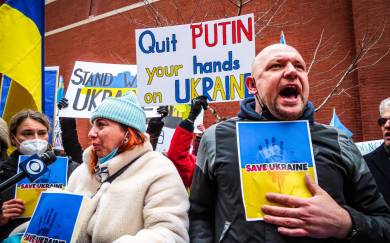Russia’s attack on Ukraine: day 69

Center Of Eastern Studies 05.05.2022 16:28
The aggressor troops continued to shell and bomb Ukrainian positions, Kharkiv and Mykolaiv, and undertook offensive actions on various sections of the contact line, locally improving the so-called tactical position, but generally failing to achieve success and suffering losses. On 3 May in the afternoon they were to launch a massive assault on the Azovstal combine. Ukraine’s National Security and Defence Council Secretary Oleksiy Danilov said the country did not have enough heavy weaponry to deblock Mariupol.
On the same day, rocket attacks took place in eight oblasts, mainly on railway supply system facilities – six traction substations in Dnipropetrovsk, Kirovohrad, Lviv (three facilities) and Zakarpattia (in Zakarpattia the gas pipeline in Volovets was damaged). In addition, targets were attacked in Donetsk, Kyiv, Vinnytsia and Odesa oblasts (in the Artsyz region on the route from Romania to Odesa; on 2 May there was another strike on the recently partially opened railway bridge over the Dniester Liman). The Russian defence ministry announced the use of Oniks winged rockets, hitherto considered a weapon for destroying ships, to attack targets in the Odesa Oblast. This gave rise – after a pause of several weeks – to new media reflections on the depletion of the invader’s stock of precision weapons.
According to the Main Reconnaissance Directorate of the Ministry of Defence of Ukraine, a recruitment drive for contract service has been activated in Russia, targeting citizens of Siberia and the Far East. Recruitment quotas of 200 ‘volunteers’ per week are to be in place, with priority given to those with military experience.
The Head of the Personnel Board of the Staff of the Land Forces of Ukraine presented data on the course and prospects of mobilization. At the end of February and the beginning of March the manpower of the units was fully completed. Since then, the rate of recruitment has slowed down and is associated with the need for their ongoing replenishment. It is possible that mobilisation will continue after 24 May (the current one has been announced for three months), but no information has been provided on the army’s main needs in terms of military specialisations.
In the occupied Kherson Oblast, a ‘war for the Internet’ is underway. On 30 April, the aggressor cut off most Ukrainian operators and rerouted network traffic through its infrastructure, meaning it is routed through Russia and subject to censorship. Ukrainian telecoms operators are able to provide telephone services on 70% of the Oblast’s territory, but cannot maintain mobile internet access.
The head of Ukrainian military intelligence, Kyrylo Budanov, said that the invaders planned to create two provinces in the occupied territories. The first, called Taurida (which was part of the Russian Empire from 1802 to 1917), is to include the territory of Crimea and parts of the Kherson and Mykolaiv oblasts, and the second – the Odesa Oblast, the city of Dnipro and parts of the Kherson, Mykolaiv and Donetsk oblasts. The Kremlin was yet to decide whether the occupied Donbas territories would be incorporated into Russia. Budanov warned that the aggressor wanted to orchestrate a humanitarian disaster to force the local population to accept aid on condition of accepting the new political reality. He also announced that the Russians were suffering from a significant shortage of personnel, and that collaborators – due to effective resistance and lack of popular support – were unable to manage the occupied localities.
The invaders exported a third of the grain reserves (about 400,000 tonnes) from the occupied territories in an attempt to reduce shortages in some regions of Russia. According to Kyiv, about 1.3 million tonnes of grain remain in the occupied territories, which is needed to ensure the food security of the population and to carry out sowing of spring crops.
On 3 May, Ukraine’s Verkhovna Rada voted a final ban on pro-Russian political parties (their activity was suspended in March) whose programme and activities deny or justify Russian armed aggression, portray it as a civil war and glorify or justify those contributing to it. The parliament also adopted amendments to the law ‘On the foundations of national resistance’ allowing territorial defence forces (TDF) to carry out tasks independently in areas of combat operations. This shows that the armed forces need immediate support on the front line. TDF can cover sections where there is no intense fighting, allowing regular troops to be redeployed to where enemy attacks are ongoing.
The Verkhovna Rada was addressed – for the first time since the outbreak of war – by President Volodymyr Zelensky, who appealed to its members to be united and not to waste time on legislation of secondary importance. He stressed that they were MPs of ‘the greatest country at the moment’ and therefore should be guided by ‘rationalism and healthy nationalism’. In turn, in an interview with The Wall Street Journal, he expressed his belief that a ceasefire could only come about as a result of a meeting between the presidents of the warring parties and the formal signing of an agreement. At the same time, he stressed that Ukraine would never accept the frozen conflict and Russia’s territorial gains..read more







